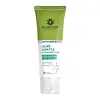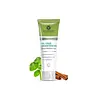What's inside
What's inside
 Key Ingredients
Key Ingredients

No key ingredients
 Benefits
Benefits

 Concerns
Concerns

No concerns
 Ingredients Side-by-side
Ingredients Side-by-side

Water
Skin ConditioningDisodium Laureth Sulfosuccinate
CleansingCocamidopropyl Betaine
CleansingPropanediol
SolventGlycerin
HumectantAloe Barbadensis Leaf Extract
EmollientHamamelis Virginiana Leaf Extract
Skin ConditioningPolyacrylate Crosspolymer-6
Emulsion StabilisingAlcohol
AntimicrobialCitrus Limon Fruit Extract
MaskingChlorphenesin
AntimicrobialSalicylic Acid
MaskingRheum Palmatum Root Extract
AstringentAllantoin
Skin ConditioningHoney
HumectantPortulaca Oleracea Extract
Skin ConditioningParfum
MaskingCitric Acid
BufferingWater, Disodium Laureth Sulfosuccinate, Cocamidopropyl Betaine, Propanediol, Glycerin, Aloe Barbadensis Leaf Extract, Hamamelis Virginiana Leaf Extract, Polyacrylate Crosspolymer-6, Alcohol, Citrus Limon Fruit Extract, Chlorphenesin, Salicylic Acid, Rheum Palmatum Root Extract, Allantoin, Honey, Portulaca Oleracea Extract, Parfum, Citric Acid
Water
Skin ConditioningXanthan Gum
EmulsifyingSodium Acrylates Crosspolymer-2
AbsorbentSodium Allantoin PCA
Skin ConditioningChlorphenesin
AntimicrobialPhenoxyethanol
PreservativeGlycerin
HumectantPropanediol
SolventSodium Hyaluronate
HumectantCentella Asiatica Extract
CleansingCinnamomum Zeylanicum Bark Extract
AntimicrobialPanthenol
Skin ConditioningNiacinamide
SmoothingRoyal Jelly
Arbutin
AntioxidantResveratrol
AntioxidantPolyquaternium-7
 Reviews
Reviews

Ingredients Explained
These ingredients are found in both products.
Ingredients higher up in an ingredient list are typically present in a larger amount.
Chlorphenesin is a synthetic preservative. It helps protect a product against bacteria in order to extend shelf life. In most cases, Chlorphenesin is paired with other preservatives such as phenoxyethanol and caprylyl glycol.
Chlorphenesin is a biocide. This means it is able to help fight the microorganisms on our skin. It is also able to fight odor-releasing bacteria.
Chlorphenesin is soluble in both water and glycerin.
Studies show Chlorphenesin is easily absorbed by our skin. You should speak with a skincare professional if you have concerns about using Chlorphenesin.
Learn more about ChlorphenesinGlycerin is already naturally found in your skin. It helps moisturize and protect your skin.
A study from 2016 found glycerin to be more effective as a humectant than AHAs and hyaluronic acid.
As a humectant, it helps the skin stay hydrated by pulling moisture to your skin. The low molecular weight of glycerin allows it to pull moisture into the deeper layers of your skin.
Hydrated skin improves your skin barrier; Your skin barrier helps protect against irritants and bacteria.
Glycerin has also been found to have antimicrobial and antiviral properties. Due to these properties, glycerin is often used in wound and burn treatments.
In cosmetics, glycerin is usually derived from plants such as soybean or palm. However, it can also be sourced from animals, such as tallow or animal fat.
This ingredient is organic, colorless, odorless, and non-toxic.
Glycerin is the name for this ingredient in American English. British English uses Glycerol/Glycerine.
Learn more about GlycerinPropanediol is an all-star ingredient. It softens, hydrates, and smooths the skin.
It’s often used to:
Propanediol is not likely to cause sensitivity and considered safe to use. It is derived from corn or petroleum with a clear color and no scent.
Learn more about PropanediolWater. It's the most common cosmetic ingredient of all. You'll usually see it at the top of ingredient lists, meaning that it makes up the largest part of the product.
So why is it so popular? Water most often acts as a solvent - this means that it helps dissolve other ingredients into the formulation.
You'll also recognize water as that liquid we all need to stay alive. If you see this, drink a glass of water. Stay hydrated!
Learn more about Water